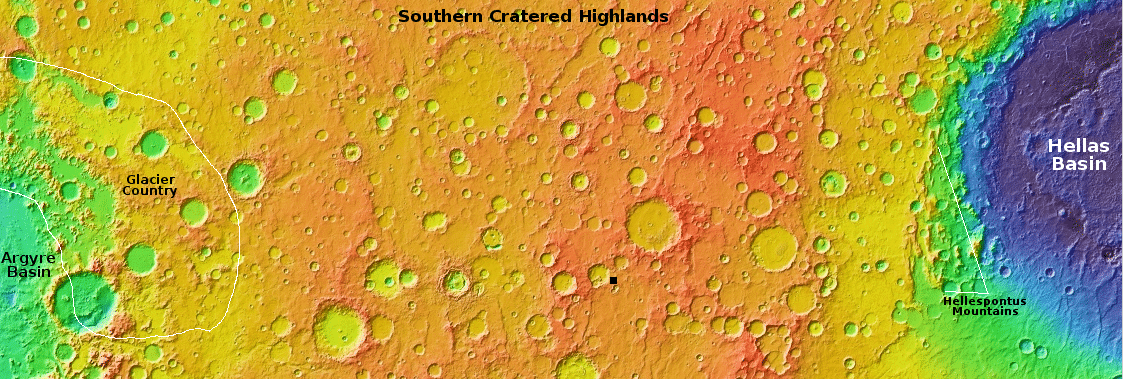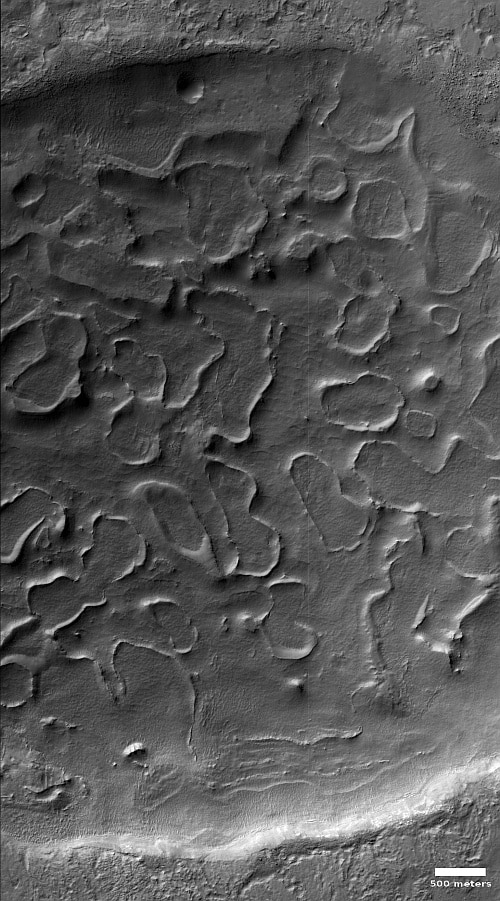The peeling floor of a crater in the southern cratered highlands

From Argyre Basin to Hellas Basin is about 7,000 miles.
Cool image time! The picture to the right, rotated, cropped, reduced, and sharpened to post here, was taken on February 25, 2023 by the high resolution camera on Mars Reconnaissance Orbiter (MRO).
The scientists labeled this image “Crater fill”, but that hardly suffices. First, the fill appears at first glance to resemble peeling paint. At closer inspection, rather than peeling paint we have instead a collection of ridges vaguely resembling cave rimstone dams that either enclose a blob-shaped region or simply meander about until they reach the crater’s interior rim.
The crater interior itself appears largely filled with material so that its rims are subdued. The location, as indicated by that black dot near the center of the overview map above, marks the location at 49 degrees south latitude, in the middle of the cratered southern highlands of Mars where many craters have strangely eroded interiors.
What makes this crater however more puzzling is that none of the surrounding nearby craters look like this. A context camera image taken March 23, 2019 shows that while some of the nearby craters have what appears to be glacial material in their interiors, none exhibit these meandering ridges. This crater stands unique, for reasons that are utterly unknown.
Are these ridges a manifestation of the glacial material filling the crater? Or are they bedrock sticking up through that glacial debris? Your guess is as good as mine.
On Christmas Eve 1968 three Americans became the first humans to visit another world. What they did to celebrate was unexpected and profound, and will be remembered throughout all human history. Genesis: the Story of Apollo 8, Robert Zimmerman's classic history of humanity's first journey to another world, tells that story, and it is now available as both an ebook and an audiobook, both with a foreword by Valerie Anders and a new introduction by Robert Zimmerman.
The print edition can be purchased at Amazon or from any other book seller. If you want an autographed copy the price is $60 for the hardback and $45 for the paperback, plus $8 shipping for each. Go here for purchasing details. The ebook is available everywhere for $5.99 (before discount) at amazon, or direct from my ebook publisher, ebookit. If you buy it from ebookit you don't support the big tech companies and the author gets a bigger cut much sooner.
The audiobook is also available at all these vendors, and is also free with a 30-day trial membership to Audible.
"Not simply about one mission, [Genesis] is also the history of America's quest for the moon... Zimmerman has done a masterful job of tying disparate events together into a solid account of one of America's greatest human triumphs."--San Antonio Express-News

From Argyre Basin to Hellas Basin is about 7,000 miles.
Cool image time! The picture to the right, rotated, cropped, reduced, and sharpened to post here, was taken on February 25, 2023 by the high resolution camera on Mars Reconnaissance Orbiter (MRO).
The scientists labeled this image “Crater fill”, but that hardly suffices. First, the fill appears at first glance to resemble peeling paint. At closer inspection, rather than peeling paint we have instead a collection of ridges vaguely resembling cave rimstone dams that either enclose a blob-shaped region or simply meander about until they reach the crater’s interior rim.
The crater interior itself appears largely filled with material so that its rims are subdued. The location, as indicated by that black dot near the center of the overview map above, marks the location at 49 degrees south latitude, in the middle of the cratered southern highlands of Mars where many craters have strangely eroded interiors.
What makes this crater however more puzzling is that none of the surrounding nearby craters look like this. A context camera image taken March 23, 2019 shows that while some of the nearby craters have what appears to be glacial material in their interiors, none exhibit these meandering ridges. This crater stands unique, for reasons that are utterly unknown.
Are these ridges a manifestation of the glacial material filling the crater? Or are they bedrock sticking up through that glacial debris? Your guess is as good as mine.
On Christmas Eve 1968 three Americans became the first humans to visit another world. What they did to celebrate was unexpected and profound, and will be remembered throughout all human history. Genesis: the Story of Apollo 8, Robert Zimmerman's classic history of humanity's first journey to another world, tells that story, and it is now available as both an ebook and an audiobook, both with a foreword by Valerie Anders and a new introduction by Robert Zimmerman.
The print edition can be purchased at Amazon or from any other book seller. If you want an autographed copy the price is $60 for the hardback and $45 for the paperback, plus $8 shipping for each. Go here for purchasing details. The ebook is available everywhere for $5.99 (before discount) at amazon, or direct from my ebook publisher, ebookit. If you buy it from ebookit you don't support the big tech companies and the author gets a bigger cut much sooner.
The audiobook is also available at all these vendors, and is also free with a 30-day trial membership to Audible.
"Not simply about one mission, [Genesis] is also the history of America's quest for the moon... Zimmerman has done a masterful job of tying disparate events together into a solid account of one of America's greatest human triumphs."--San Antonio Express-News



My guess is Sand dunes covered in material like hot ash that forms a crust, The tops of which eroded away letting the wind blow the sand out of the the soft center leaving the sculptured look.
A beautiful mystery.
Max: I like your hypothesis.
What about something that shattered on impact? The big crater is the whole thing, then it crunched and the harder parts of it created splashes? I have no idea if that’s something that happens.
The crater looks very flat, not the inverted cone shape of a rock crashing in. Perhaps something icy? The heat of the crash vaporized a lot of what created the big crater and what was left created mini craters inside.
If nothing around it looks similar, it seems that the impactor would be the most likely difference.